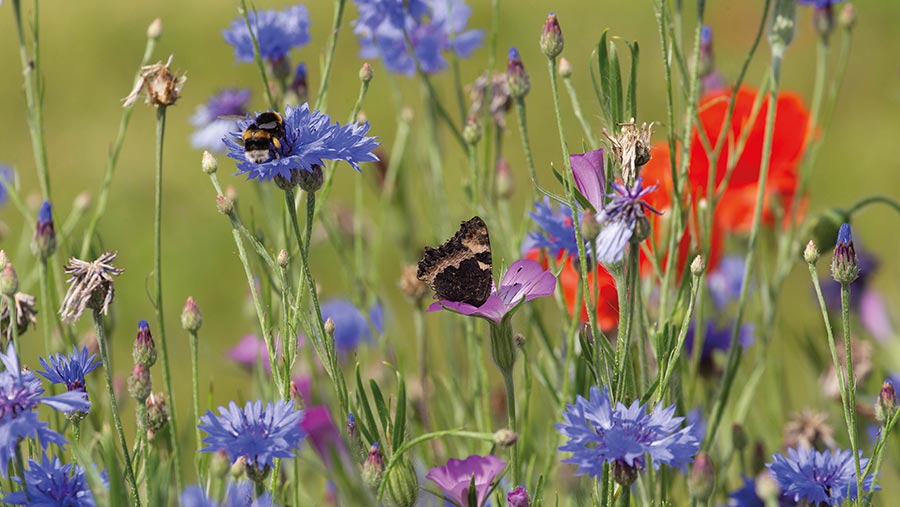Key lessons from £12m arable farming and wildlife project
 © Tim Scrivener
© Tim Scrivener A better understanding of the contribution made by nature-based solutions to improving the resilience of productive arable land and its ability to deliver higher yields has come from the recently completed Assist project.
Following six years of work done by a collaborative team of scientists and an 18-strong farmer network, yield increases of between 16-18% were recorded where both field edge and in-crop conservation measures had been included to support wildlife and biodiversity.
See also: Can arable farming and wildlife conservation work together?
The use of cover crops, wildlife field margins, farmyard manure applications and in-field flowering strips all helped with pollination, pest regulation and soil function – demonstrating the ecosystem services provided by such measures.
As such, Assist has highlighted the benefits of good, sustainable farming practices and shown growers how to start making the changes that wider society requires of them, reports researcher Jon Storkey of Rothamsted Research.
Another key finding was the recognition that it takes time for biological systems and their processes to react, as was confirmation that flexible agri-environment management options can work at the farm level.
“There’s often a time lag between introducing these options and seeing their effects – these results were recorded four years after their introduction,” explains Ben Woodcock, an ecological entomologist at the UK Centre for Ecology and Hydrology (UKCEH).
“We also saw that combinations of the various measures employed were effective, which is important for the design of future government schemes and their suitability for different farms.”
Set up to help farmers meet ambitious environmental goals expected from new farming policy based on “public money for public goods”, the Assist project was undertaken by the UKCEH, Rothamsted Research and the British Geological Survey.
Farmer findings
Large predatory ground beetles were more abundant, with higher numbers in the middle of fields where nature-based solutions were tested at the Hendred Farm Partnership in Oxfordshire.
Fields where in-field flowering strips were combined with the use of cover crops, farmyard manure and field margins gave the most encouraging results on beneficials, while springtail numbers were also higher.
A good indicator of soil health in terms of organic matter and bioactivity, springtails were measured using pitfall traps placed in the field – with more found in treatment 3, which combined all of the management options.
Farm manager Julian Gold says that the in-field strips are an obvious way of bringing biodiversity into fields and he has since rolled them out across the whole farm, using Countryside Stewardship options AB1 and AB8 to help fund them.
“They have helped move us towards systems thinking, rather than short-term fixes, which is what natural capital payments will be based on,” he notes.
However, having flowering strips going through the middle of fields isn’t an easy management option, he points out. “They do require work to get them established successfully and we have lost flowering species over time, so they will have to be re-sown.”
Natural capital
Funded by the Natural Environment Research Council (NERC) and the Biotechnology and Biological Sciences Research Council (BBSRC), to the tune of £12m, it looked at how to make best use of natural capital to support food production and minimise any negative environmental impacts that can arise from modern, commercial farm practice.
Known in the farming community for its use of flowering strips through the middle of fields to support beneficial insect populations and encourage natural enemies, these strips have since been adopted across farms to replace insecticides.
Their use provides a means of getting beneficial insects into the middle of arable fields, helping to get the natural enemies into place before the exponential increase in pest numbers that can occur.
The Assist data is available through several digital tools – e-planner, e-surveyor and e-viewer – which can be used free of charge to help with the planning and monitoring of wildlife habitats, as well as to visualise the future effects of land use decisions.
“Knowing where to place any habitat to get the maximum benefit from it, as well as how it is performing, helps farmers to take the right steps as they target nature-based solutions and deliver the best environmental outcomes,” says John Redhead, a spatial ecologist at the UKCEH.
New project: Clean, green and net zero
A new five-year research programme on how to achieve sustainable, carbon neutral farming will follow Assist, with funding from BBSRC and NERC agreed.
With a working title of Clean, Green and Net Zero+ Agriculture, the project will follow a whole farm systems approach to support the industry, building on the collaborative science and farming communities already established.
As agriculture contributes 10% of the UK’s greenhouse gas emissions, the work will look at the footprint of farming businesses and investigate any trade-offs or compromises that are made to produce food, as well as innovations that are claimed to help.
“The new challenge for farmers is to keep producing food, but with zero emissions and while enhancing biodiversity and improving soil, water and air quality,” notes Richard Pywell of UKCEH.
“It’s a big ask. Changing management practices – perhaps by including legumes in the rotation and using cover crops, or bringing livestock into the system – have to be evaluated for what they can bring to any farming business. Are they all doing the good that is believed about them?”

